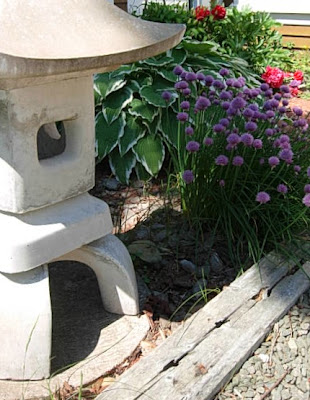At the entrance to the gallery is a small Zen-style sand garden, which I rake faithfully-----well, OK, at least after each rainfall or after Cherub, the marmalade cat, has rolled and scratched his back in the warm sand.
No, it's not what you think---he never messes, for he has great respect for things Zen. No, he rolls in my beautiful sand design when he is pissed off at me. For example, when I won't let him into the gallery despite his plaintive cries at the glass door.
So he goes right to the Zen garden and rearranges things.
The Buddha of Zen laughs and laughs. He likes all manner of feisty 'cats' of this world who challenge belief systems and do it with humour and without desecration.
This garden is a faint reflection of my memory of the famous "dry" garden at Ryoan-ji (Peaceful Dragon Temple) in Kyoto which is, yes, definitely raked daily by the monks.
Recently a lady stopped in to visit the gallery for the first time. She has never traveled outside of the Province of Nova Scotia. This would be her first experience to visit an truly oriental environment and she was quite thrilled.
As she entered, she pointed behind her to the Zen sand garden and said, "Your garden is coming along..."
Being puzzled at her meaning, I answered in a typically polite and evasive Japanese fashion and agreed with her and thanked her for what obviously was a compliment.
Inside the gallery, she was like a young girl back in school on a field trip, marvelling at the beauty of objects and architecture alike. And the kimonos! She was overcome with excitement to experience a taste of such an exotic culture, one that only in her dreams would she ever actually visit.
Finishing her green tea and wishing to express her joy and appreciation as she left, she commented once again on my sand garden.
Pointing to the carefully created, narrow rows in the sandy gravel, she left me a final compliment---- " Your garden will be awfully lovely when your plants begin coming up."
I thanked her kindly and sincerely for her visit----naive, uninformed, but a very pleasant person.
But then my mind began to churn. And in the background I could hear the Buddha of Zen laughing louder than ever---at me---his belly shaking.
The question arose--- is there any room in the gardens of my preconceptions for more than just a rigid formula of sand and 5 stones?
Like vegetables?
Or humour?
How about a geisha napping?
But then my mind began to churn. And in the background I could hear the Buddha of Zen laughing louder than ever---at me---his belly shaking.
The question arose--- is there any room in the gardens of my preconceptions for more than just a rigid formula of sand and 5 stones?
Like vegetables?
Or humour?
How about a geisha napping?
Of course, that must be done only with an authentic Zen meditation pillow...
(laughter...)
PS: Seconds before I took this second image, a gentle wind blew the right sleeve of her kimono across her in a more feminine gesture.
This bunraku geisha definitely did not like the first poise...









